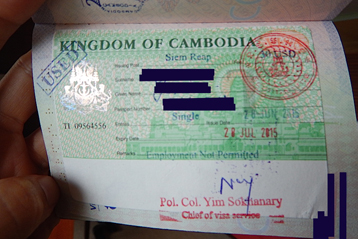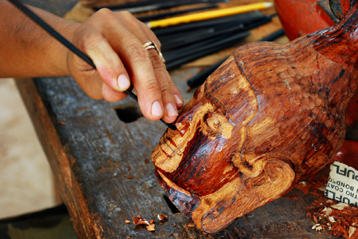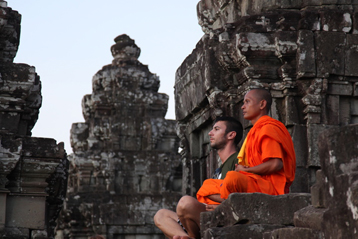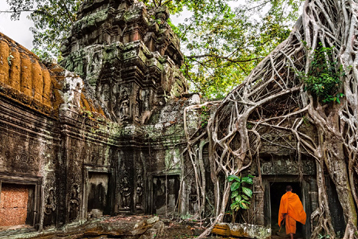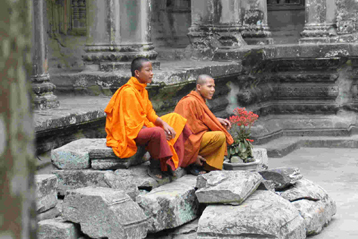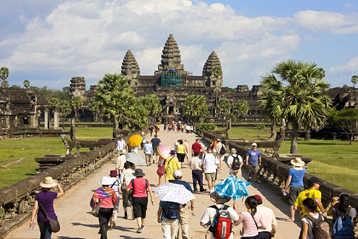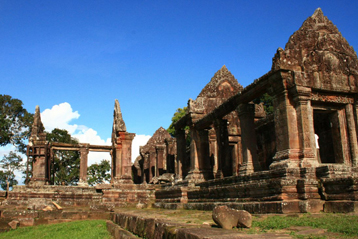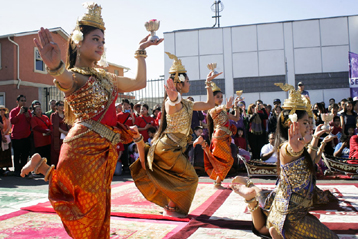Angkor Wat
Angkor Wat is simply unique, a stunning blend of spirituality, and symmetry, an enduring example of man’s devotion to his gods.
Angkor Wat is simply unique, a stunning blend of spirituality, and symmetry, an enduring example of man’s devotion to his gods. Relish the very first approach, as that spine-tickling moment when you emerge on the inner causeway will rarely be felt again. It is the largest and undoubtedly the most breathtaking of the monuments at Angkor, and is widely believed to be the largest religious structure in the world. It is also the best-preserved temple at Angkor, as it was never abandoned to the elements, and repeat visits are rewarded with previously unnoticed details. It was probably built as a funerary temple for Suryavarman II to honor Vishnu, the Hindu deity with whom the king identified.
There is much about Angkor Wat that is unique among the temples of Angkor. The most significant point is that the temple is oriented towards the west. West is symbolically the direction of death, which once led a large number of scholars to conclude that Angkor Wat must have existed primarily as a tomb. This idea was supported by the fact that the magnificent bas-reliefs of the temple were designed to be viewed in an anticlockwise direction, a practice that has precedents in ancient Hindu funerary rites. Vishnu, however, is also frequently associated with the west, and it is now commently accepted that Angkor Wat most likely served both as a temple and a mausoleum for Suryavarman II.
Apsara
Angkor Wat is famous for its beguiling apsara (heavenly nymphs). There are more than 3000 carved into the walls of the temple, each of them unique, and there are more than 30 different hairstyles for budding stylists to check out. Many of these exquisite apsara were damaged during Indian efforts to clean the temples with chemicals during the 1980s, the ultimate bad acid trip, but they are now being restored by the teams of the German Apsara Conservation Project (GACP; www.gacp-angkor.de). The organization operates a small information booth in the northwest corner of Angkor Wat, near the wat, where beautiful black-and-white postcards and images of Angkor are available.
SYMBOLISM
Visitors to Angkor Wat are struck by its imposing grandeur and, at close quarters, its fascinating decorative flourishes and extensive bas-reliefs; however, a scholar at the time of its construction would have reveled in its multilayered levels of meaning in much the same way as a contemporary literary scholar might delight in James Joyce’s Ulysses.
David Chandler, drawing on the research of Eleanor Moron, points out in his book History of Cambodia that the spatial dimensions of Angkor Wat parallel the lengths of the four ages (Yuga) of classical Hindu thought. Thus the visitor to Angkor Wat who walks the causeway to the lain entrance and through the courtyards to the final main tower, which once contained a statue of Vishnu, is metaphorically traveling back to lie First age of the creation of the universe.
Monk at Angkor
Like the other temple-mountains of Angkor, Angkor Wat also replicates the spatial universe in miniature. The central tower is Mt Meru, with its surrounding smaller peaks, bounded in turn by continents (the lower courtyards) and the oceans (the moat). The seven-headed naga becomes a symbolic rainbow bridge for man to reach the abode of the gods.
ARCHITECTURAL LAYOUT
Angkor Wat is surrounded by a moat, 190m wide, which forms a giant retangle measuring 1.5km by 1.3km. It makes the moats around European castles look like kid’s play. From the west, a sandstone causeway crosses the moat; the holes in the paving stones held wooden pegs that were used to lift and position the stones during construction. The pegs were then sawn off and have since rotted away. The sandstone blocks from which Angkor Wat was built were quarried more than 50km away (from the district of Svay Leu at the eastern foot of PhnomKulen) and floated down the Stung Siem Reap (Siem Reap River) on rafts. The logistics of such an operation are mind-blowing, consuming the labor of thousands – an unbelievable feat given the lack of cranes and trucks that we take for granted in contemporary construction projects.
The rectangular outer wall, which measures 1025m by 800m, has a gate on each side, but the main entrance, a 235m-wide porch richly decorated with carvings and sculptures, is on the western side. In the gate tower to the right as you approach is a statue of Vishnu, 3.25m in height and hewn from a single block of sandstone. Vishnu’s eight arms hold a mace, a spear, a disk, a conch and other items. You may even see locks of hair lying about. These are an offering by both young women and men preparing to get married or by people who seek to give thanks for their good fortune.
The central temple complex consists of three storeys, each made of laterite, which enclose a square surrounded by intricately interlinked galleries. The Gallery of a Thousand Buddhas used to house hundreds of Buddha images before the war, but many of these were removed or stolen, leaving the broken remnants we see today.
The corners of the second and third storeys are marked by towers, each topped with pointed cupolas (domed structures). Rising 31m above the third level and 55m above the ground is the central tower, which gives the whole ensemble its sublime unity.
At one time, the central sanctuary of Angkor Wat held a gold statue of Vishnu mounted on a garuda (a mythical half-man, half-bird creature) that represented the deified god-king Suryavarmari II. The stairs to the upper level are immensely steep, because reaching the kingdom of the gods was no easy task; modern-day visitors should exercise due care and caution when clambering up or down, as the stairs have claimed victims before.
Once at the central tower, the pilgrimage is complete: soak up the breeze, take in the views and then find a quiet corner in which to contemplate the symmetry and symbolism of this Everest of temples.
Angkor Wat
BAS-RELIEFS
Stretching around the outside of the central temple complex is an 800m long series of intricate and astonishing bas-reliefs. The carvings were once sheltered by the cloister’s wooden roof, which long ago rotted away (except for one original beam in the western half of the north gallery; he other roofed sections are reconstructions). The following is a brief description of the epic events depicted on the panels in the gallery of bas-reliefs. They are described in the order in which you’ll come to them if you begin on the western side and keep the bas-reliefs to your left. The majority of the bas-reliefs were completed in the 12th century, but in the 16th century several new reliefs were added to unfinished panels.
(A) Battle of Kurukshetra
The southern portion of the west gallery depicts a battle-scene from the Hindu Mahabharata epic, in which the Kauravas (coming from the north) and the Pandavas (coming from the south) advance upon each other, meeting in furious battle. Infantry are shown on the lowest tier, with officers on elephant-back and chiefs on the second and third tier. Some of the more interesting details (from left to right) include: a dead chief lying on a pile of arrows and surrounded by his grieving parents and troops; a warrior on an elephant who, by putting down his weapon, has accepted defeat; and a mortally wounded officer, falling from his carriage into the arms of his soldiers. Over the centuries, some sections have been polished (by the millions of hands that fall upon them) to look like black marble. The portico at the southwestern corner is decorated with sculptures representing subjects taken from the Ramayana.
(B) Army of Suryavarman II
The remarkable western section of the south gallery depicts a triumphal battle-march of Suryavarman II’s army. In the southwestern corner about 2m from the floor’s Suryavarman II on an elephant, wearing the royal tiara and armed with a battle-axe; he is shaded by 15 umbrellas and fanned by legions of servants. Further on is a procession of well-armed soldiers and officers on horseback; among them are bold and warlike chiefs on elephants. Just before the end of this panel is the rather disorderly Thai mercenary army, with their long headdresses and ragged marching, at that time allied with the Khmers in their conflict with the Chams. The Khmer troops have square breastplates and are armed with spears; the Thais wear skirts and carry tridents.
The rectangular holes seen in this stretch were treated when, long ago, pieces of the scene – reputed to possess magical powers – were removed. Part of this panel was damaged by an artillery shell in 1971.
(C) Heaven & Hell
The eastern half of the south gallery, the ceiling of which was restored in the 1930s, depicts the punishments and rewards of the 37 heavens and 32 hells. On the left the upper and middle tiers show fine gentlemen and ladies proceeding towards 18-armed Yama (the judge of the dead) seated on a bull; below him are his assistants, Dharma and Sitragupta. On the lower tier is the road to hell, along which the wicked are dragged by devils. To Yama’s right, the tableau is divided into two parts by a horizontal line of garuda (half-man, half-bird creatures): above, the elect dwell in beautiful mansions, served by women, children and attendants; below, the condemned suffer horrible tortures.
(D) Churning of the Ocean of Milk
The southern section of the east gallery is decorated by the most famous of the bas-relief scenes at Angkor Wat, the Churning of the Ocean of Milk. This brilliantly executed carving depicts 88 asura (devils; on the left), and 92 deva (gods) with crested helmets, churning up the sea to extract the elixir of immortality, which both sides covet. The demons hold the head of the serpent and the gods hold its tail. At the centre of the sea, the serpent is coiled around Mt Mandala, which in the tug of war between the demons and the gods turns and churns up the water. Vishnu, incarnated as a huge turtle, lends his shell to serve as the base and pivot of Mt Mandala. Brahma, Shiva, Hanuman (the monkey god) and Lakshmi (the goddess of beauty) all make appearances, while overhead a host of heavenly female spirits sing and dance in encouragement. Luckily for us the gods won through, as the apsara (heavenly nymphs) above were too much for the hot-blooded devils to take.
(E) Elephant Gate
This -gate, which has no stairs leading to it, was used by the king and others for mounting and dismounting elephants directly from the gallery. North of the gate is a Khmer inscription recording the erection of a nearby stupa in the 18th century.
(F) Vishnu Conquers the Demons
The northern section of the east gallery .shows a furious and desperate encounter between Vishnu, riding on garuda and innumerable danava (demons). Needless to say, he slays all comers. This gallery was only completed at a later date, most likely in the 16th century, and the carving is notably inferior to the original work from the 12th century.
(G) Krishna & the Demon King
The eastern section of the north gallery shows Vishnu incarnated as Krishna riding a garuda. He confronts a burning walled city, the residence of Bana, the demon king. The garuda puts out the fire and Bana is captured. In the final scene Krishna kneels before Shiva and asks that Bana’s life be spared.
(H) Battle of the Gods & the Demons
The western section of the north gallery depicts the battle between the 21 gods of the Brahmanic pantheon with various demons. The gods are feared with their traditional attributes and mounts. Vishnu, for example, has four arms and is seated on a garuda, while Shiva rides a sacred goose.
(I) Battle of Lanka
The northern half of the west gallery shows scenes from the Ramayana. In the Battle of Lanka, Rama (on the shoulders of Hanuman), along with his army of monkeys, battles 10-headed Ravana, seducer of Rama’s beautiful wife Sita. Ravana rides a chariot drawn by monsters and commands an army of giants.
More guide...
Responsible Travel
Being a responsible eco tour operator is at the heart of what ACTIVETRAVEL ASIA is all about. From the start, we have been committed to offering low-impact tours that benefit traveler and host alike. We work with local communities, businesses and individuals to develop sustainable tourism opportunities that help local economies while minimizing negative environmental and cultural impacts.
Asia Travel News


